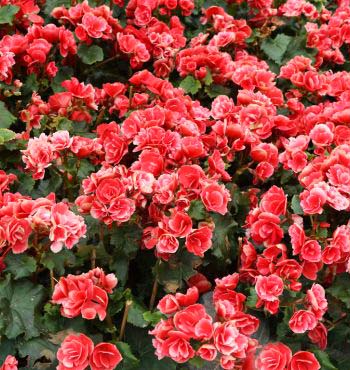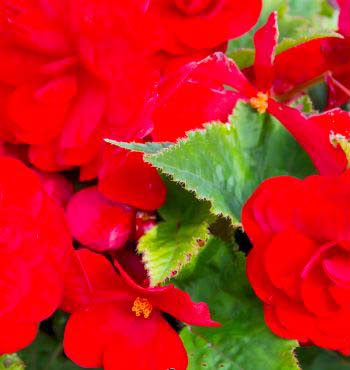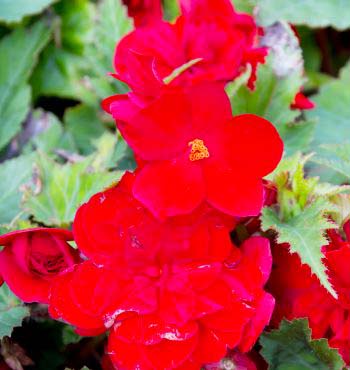Red Begonias are beautiful flowering plants that belong to the Begoniaceae family and are known for their vibrant red petals. Red Begonias are stunning flowering plants with vibrant red petals, making them a popular choice for gardens and decorative arrangements.
As members of the Begoniaceae family, they possess a unique charm and add a touch of color to any space. These plants also vary in size and can be easily grown both indoors and outdoors. Red Begonias are known for their ability to thrive in partial shade, making them versatile and adaptable plants.
Whether used as a focal point in a garden or as a bright splash of color on a windowsill, red begonias are sure to catch the eye and add beauty to any environment.
The Origin Of Red Begonia
The charming Red Begonia is a popular flowering plant known for its vibrant red blossoms and lush foliage. But have you ever wondered about its origin? Let’s delve into the fascinating journey of this beautiful plant, from its discovery and early cultivation to the varieties and cultivation practices used today.
Discovery And Early Cultivation
Red Begonia were first discovered in the early 18th century by botanists who were exploring the tropical regions of South America. Their striking appearance and ability to thrive in diverse climates quickly captured the attention of plant enthusiasts, leading to their cultivation in various parts of the world.
Early cultivation of Red Begonias primarily took place in European countries such as England and France. Gardeners and horticulturists experimented with different growing conditions to refine their cultivation techniques, resulting in the development of new varieties and hybrids.
Varieties And Cultivation Today
Today, the Red Begonia boasts an extensive range of varieties, each with its own unique characteristics. These varieties vary in size, growth habit, and flower forms. From compact bedding plants to cascading hanging varieties, there is a Red Begonia suitable for every gardening preference.
| Variety Name | Description |
| Boliviensis | A vigorous trailing variety with tubular flowers. |
| X tuberhybrida | A hybrid variety with large, showy blooms that come in various shades of red. |
| Semperflorens | A popular bedding plant variety with compact growth and abundant blooms. |
To cultivate Red Begonias successfully, it is essential to provide them with well-draining soil, abundant sunlight, and regular watering. These plants thrive in moderate climates but can also tolerate a certain level of heat and humidity.
Whether you choose to grow Red Begonias in containers, hanging baskets, or garden beds, be sure to provide them with adequate space to spread their vibrant blooms and lush foliage. Prune regularly to maintain their compact form and promote continuous flowering.
In conclusion, the Red Begonia is not only a visually breathtaking flowering plant, but it also has an intriguing history. From its discovery in South America to its widespread cultivation across the globe, this plant continues to captivate the hearts of gardeners and nature enthusiasts alike.
The Science Behind The Red Begonia’s Vibrancy

The red begonia is a beautiful flowering plant that captivates us with its stunning vibrancy. But have you ever wondered what makes it so red? The answer lies in the science behind its genetic makeup and the influence of environmental factors. Let’s delve into these fascinating aspects to understand why the red begonia possesses its striking color.
Genetic Makeup And Pigmentation
The red begonia owes its vibrant hues to its genetic makeup and the pigments it produces. Within its DNA, specific genes are responsible for the synthesis of pigments that contribute to the plant’s red coloration. These pigments, scientifically known as anthocyanins, are synthesized through a complex biochemical pathway, resulting in variances in color intensity and shades ranging from pale pink to deep crimson.
The production of anthocyanins in the red begonia is regulated by various factors such as gene expression, enzyme activity, and genetic mutations. Different varieties and cultivars may possess unique genetic variations that determine the specific shades of red exhibited by their flowers. These genetic differences make each red begonia visually distinct, adding to the allure of this enchanting plant.
Environmental Factors
In addition to its genetic makeup, the red begonia’s vibrancy can also be influenced by environmental factors. Light, temperature, soil conditions, and nutrient availability all play a role in shaping the plant’s coloration. Adequate sunlight exposure is particularly crucial for stimulating the synthesis of anthocyanins in the flowers, enhancing their red pigmentation.
Temperature fluctuations can also impact the red begonia’s color development. Cooler temperatures often result in more intense red hues, while warmer conditions may lead to lighter shades. Additionally, the pH level of the soil can affect the availability of certain nutrients necessary for pigment production. Acidic soils, for example, tend to promote stronger red coloration in the flowers.
Furthermore, environmental stresses such as water availability, drought, and even pests or diseases can influence the red begonia’s vibrancy. These stressors may trigger protective responses within the plant, causing changes in pigment production and intensity to ward off potential harm.
Understanding the science behind the red begonia’s vibrancy allows us to appreciate its remarkable beauty on a whole new level. By unraveling the plant’s genetic makeup and how it interacts with its environment, we gain insight into the intricate processes that result in the red begonia’s captivating color. It serves as a reminder of the wonders of nature and the marvelous secrets it holds.
Red Begonia – Symbolism And Cultural Significance

Historical And Cultural Associations
Red Begonias have a rich history and are deeply intertwined with various cultures worldwide. In ancient China, begonias were associated with harmony and balance due to their symmetrical form and vibrant red blooms. They were often used in traditional Chinese medicine for their healing properties and were also believed to bring good luck and prosperity.
In Victorian England, red begonias were considered a symbol of gratitude and appreciation. They were often gifted to express sincere admiration and respect for a person.
Modern Symbolism
In contemporary culture, the red begonia continues to hold significant meaning. It is often associated with passion, romance, and love. The intense red hue of the begonia flower symbolizes deep affection and commitment, making it a popular choice for gifting to loved ones and romantic partners.
Beyond romantic connotations, the red begonia also represents strength and divine beauty. Its bold color and striking appearance are seen as a symbol of determination and resilience.
Caring For Red Begonias

When it comes to caring for red begonias, it is important to understand the specific light, soil, and water requirements. Additionally, pest and disease control are crucial aspects in maintaining the health and beauty of these stunning plants. In this section, we will discuss each of these factors in detail to ensure you have all the information you need to help your red begonias thrive.
Light Requirements
Red begonias require a moderate amount of light to grow well. They prefer bright but indirect light, so placing them near a window with sheer curtains can be ideal. Avoid exposing them to direct sunlight, as it can scorch the leaves and lead to plant stress. If your red begonias are not getting enough light, they may have weak, pale or leggy growth. On the other hand, if they are exposed to too much light, their leaves may become bleached or develop brown spots.
Soil Requirements
The soil for red begonias should be well-draining and rich in organic matter. A mix of potting soil and perlite or vermiculite can help ensure proper drainage. The soil pH should be slightly acidic to neutral, ranging between 6.0 and 7.0. It’s important to avoid waterlogged or compacted soil, as it can cause root rot and hinder the plant’s overall growth. Regularly replenish the soil with organic matter to maintain its fertility and structure.
Water Requirements
Proper watering is essential for the health of your red begonias. These plants dislike both overwatering and underwatering. It is recommended to water them when the top inch of the soil feels dry. Avoid waterlogged conditions, as they can lead to root problems and fungal diseases. To maintain adequate moisture levels, you can mulch the soil surface with organic material. Additionally, using room-temperature water can help prevent shock to the plant’s roots.
Pest And Disease Control
Red begonias are susceptible to certain pests and diseases, so proactive measures are necessary to keep them at bay. Some common pests that can affect begonias include aphids, mealybugs, and spider mites. Regularly inspect your plants and, if you notice any signs of infestation, take immediate action. There are various natural and chemical control methods available, so choose the one that suits you best. Additionally, practicing good sanitation, such as removing dead leaves and debris, can help prevent the spread of diseases.
By understanding and implementing the appropriate care techniques for your red begonias, you can enjoy their vibrant beauty for years to come. Remember to provide them with the right amount of light, well-draining soil, and proper watering. Remaining vigilant against pests and diseases will ensure the longevity of your plants. Now that you have the knowledge, go ahead and give your red begonias the care they need.
Landscaping With Red Begonias

Red begonias are a stunning addition to any garden, bringing vibrant color and beauty to your outdoor space. Whether you have a small backyard or a sprawling estate, landscaping with red begonias can create a captivating and eye-catching display. In this section, we will explore how you can incorporate red begonias into your garden design and choose complementary plants to enhance their beauty. We will also discuss important seasonal considerations to ensure your red begonias thrive year-round.
Garden Design And Complementary Plants
When it comes to designing your garden with red begonias, there are numerous options to explore. Red begonias make excellent border plants, adding a pop of color and creating a defined space. Alternatively, you can use red begonias as focal points in your garden, placing them strategically to draw the eye and create visual interest.
To complement the red begonias, consider incorporating plants with contrasting foliage or blooms. For example, pairing red begonias with yellow marigolds creates a striking contrast that accentuates the vibrancy of both colors. Additionally, you can opt for plants with different heights and textures to add depth and dimension to your garden. For instance, tall purple salvia or delicate white alyssum can provide a stunning backdrop for the red begonias.
Seasonal Considerations
When planning your red begonia landscaping, it is crucial to consider the seasonal factors that can affect their growth and overall appearance. These considerations will help ensure that your red begonias remain healthy and vibrant throughout the year.
- Sunlight: Red begonias thrive in partial shade to full sunlight. It is essential to select a planting location that provides the optimum amount of sunlight for your begonias to flourish.
- Watering: Red begonias prefer well-drained soil and regular watering. Keep the soil evenly moist but not overly saturated to avoid root rot.
- Frost protection: Red begonias are not frost-tolerant, so it is crucial to protect them during colder months. Consider covering them with a protective cloth or moving potted begonias indoors.
By incorporating these seasonal considerations into your landscaping plans, you can ensure that your red begonias remain healthy and continue to enhance the beauty of your garden all year long.
FAQ For Red Begonia
Are Red Begonias Sun Or Shade Plants?
Red begonias thrive in partial shade, needing a few hours of sun daily. They prefer filtered sunlight and can tolerate some shade.
Do Red Begonias Come Back Every Year?
Yes, red begonias can come back every year. They are perennial plants that have the ability to return and bloom again in subsequent years.
Do Spotted Begonias Like Sun Or Shade?
Spotted begonias prefer bright, indirect sunlight rather than direct sun or deep shade.
Conclusion
The vibrant and resilient Red Begonia is a beautiful addition to any garden or indoor space. With its stunning red blooms and easy-care nature, it brings a pop of color and cheer to any environment. Whether used as a focal point or as part of a mixed arrangement, the Red Begonia is a versatile and delightful plant that is sure to brighten any space.






